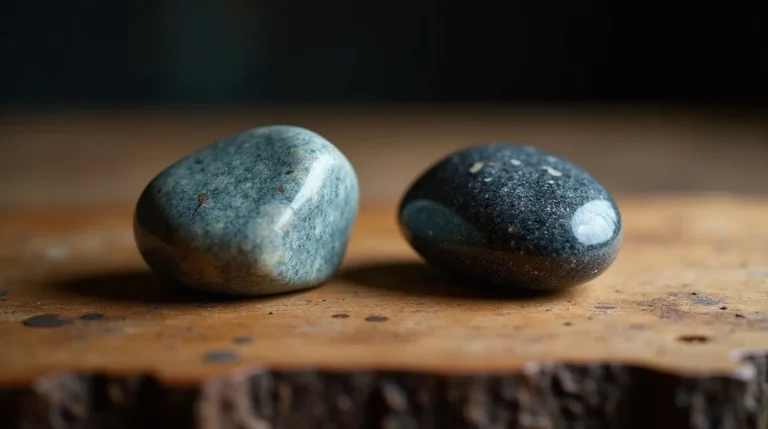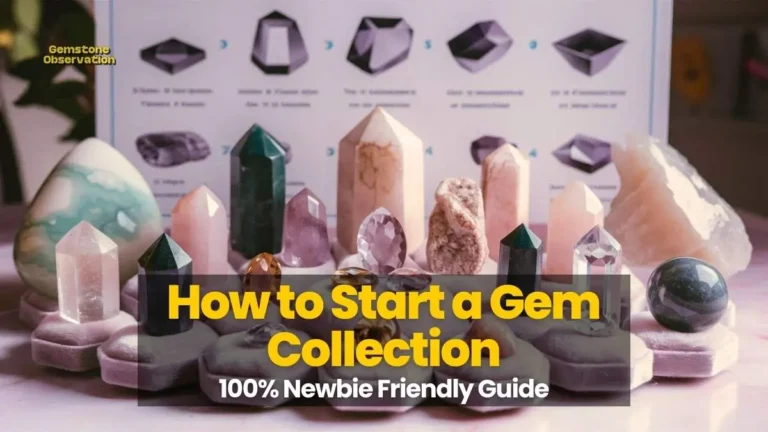When you start your next home renovation or landscaping project, picking between imperial and smooth cut stone matters a lot. This choice affects how the stone looks, how long it lasts, and its price. Think about walking through a grand, historic building with its detailed imperial-cut stones. Or picture a modern patio with smooth-cut surfaces that look seamless.
We’ll look into the main differences between these two cutting styles. We’ll also talk about the masonry skills that make them stand out. Whether you’re updating your outdoor space or designing a new look, knowing about imperial and smooth cut stones can guide your choice. It helps you pick what fits your dream best.

Understanding Stone Cutting Techniques
The way gemstones are cut greatly affects their look and appeal. There are two main cutting techniques: smooth cut and faceted cut. Knowing the differences helps you choose the right gemstone for your needs.
Smooth Cut: Plain and Cabochon Cuts
Smooth cuts, or plain cuts, have a flat or slightly curved surface. They show off the gemstone’s natural color, pattern, and shine. Cabochons, for example, have a flat bottom and a domed top. The dome’s steepness can be low or high.
Faceted Cut: Brilliant, Step, and Mixed Cuts
Faceted cuts, on the other hand, have angled surfaces that sparkle. They can be brilliant, step, or mixed cuts. Brilliant cuts have many flat planes, making the gemstone shine brightly. Step cuts show the stone’s color and clarity with parallel facets. Mixed cuts have facets on the top and a smooth surface on the bottom.
| Cut Type | Description | Characteristics |
|---|---|---|
| Smooth Cut | Plain or Cabochon Cut | Flat or slightly curved surface, showcases natural color, pattern, and luster |
| Faceted Cut | Brilliant, Step, Mixed | Multiple angled surfaces, creates sparkling, brilliant effect |

Characteristics of the Imperial Cut
The imperial cut is a unique faceting style known for excellence in gemstones. It has a deep, rounded pavilion and a high crown. This design creates exceptional brilliance and fire that catches the eye.
Originally for diamonds, the imperial cut now suits many transparent gemstones. It’s a favorite for high-end jewelry and luxury items.
The imperial cut stands out by maximizing light within the gemstone. Its deep pavilion reflects more light, and the high crown adds sparkle. This technique is famous for enhancing a gemstone’s beauty and captivating viewers.
People love the imperial cut for its timeless elegance and ability to highlight a gemstone’s qualities. It showcases the art and precision of lapidary craftsmanship. Its popularity keeps growing, making it a top choice for those who value exceptional gemstones.

Smooth Cut: Elegance in Simplicity
Smooth cut stones, like those with a cabochon cut, bring a unique elegance. Cabochons have a rounded top and a flat or slightly curved base. They are perfect for opaque or translucent stones that don’t sparkle like clear gems.
This classic cut lets the stone’s natural beauty shine. It highlights the stone’s unique features.
Cabochon: A Timeless Classic
The cabochon cut has a rich history in jewelry design. It’s great for showing off the beauty of smooth cut stones. The cabochon’s smooth surface reflects light softly, creating a stunning effect.
Cabochon stones are perfect for gems like opals, turquoise, and many quartz types. These gems may not sparkle as much as faceted ones. But the cabochon cut makes their natural beauty stand out.
The cabochon’s simplicity lets the stone’s color, pattern, and movement shine. It’s a timeless choice for many jewelry designs.

The cabochon cut adds elegance to any jewelry. It’s perfect for pendants, rings, or bracelets. Its lasting popularity shows its timeless appeal.
Faceted Cuts: Brilliance and Fire
Faceted cuts are the top choice for showing off gemstones’ beauty. These cuts are made to bring out the stone’s light and look. The brilliant cut and step cut are two favorites, each with its own charm.
Brilliant Cuts: Maximizing Sparkle
Brilliant cut gemstones, like the round brilliant, are known for their sparkle. Their triangular and kite-shaped facets make light dance in a stunning way. A well-cut brilliant cut gemstones can see its value jump by over four times, thanks to its sparkle.
Step Cuts: Revealing Color and Clarity
Step cut gemstones have rectangular facets that step up, showing off the stone’s color and clarity. Cuts like the Asscher and baguette are elegant and understated. They let the faceted cut stones shine in their own right.
Faceters can mix these styles to create unique cuts. This mix of brilliance and subtlety lets gemstone lovers pick the perfect cut for them.

The Imperial vs Smooth Cut Stone Debate
Choosing between an imperial cut and a smooth cut stone depends on your taste and the look you want. Imperial cuts are loved for their bright sparkle and fire, making them perfect for diamond rings and fancy jewelry. Smooth cuts, like cabochons, are more subtle and elegant, highlighting the stone’s natural beauty.
The debate between these styles has long fascinated the world of jewelry and gemstones. Both imperial and smooth cuts have their fans, each praising their own special qualities. The right choice depends on the project, the stone, and your design goals.
| Imperial Cut | Smooth Cut |
|---|---|
| Exceptional brilliance and fire | Understated and elegant |
| Popular for diamond engagement rings and high-end jewelry | Focuses on the stone’s natural beauty and unique characteristics |
| Prized for its optical performance | Offers a more subtle and refined appearance |
Whether you prefer the sparkle of an imperial cut or the timeless look of a smooth cut, the choice is yours. Think about your style, the stone’s qualities, and how you’ll use the piece. This will help you decide between imperial and smooth cut stone wisely.

Factors to Consider When Choosing a Cut
Choosing between an imperial or smooth cut stone involves several key factors. The stone’s type and how clear it is matter a lot. Also, think about what visual effects you want, like sparkle or color.
Stone Type and Opacity
The stone’s type and how clear it is affect the cut choice. Transparent stones like diamonds look great with faceted cuts. These cuts make them sparkle a lot.
Translucent stones, like opal, do well with smooth cuts. These cuts show off their color play. Opaque stones, such as onyx or jade, look stunning with cabochon or domed cuts. These cuts bring out their natural beauty.
Desired Visual Effects
Knowing what visual effects you want is key. For lots of sparkle, choose a brilliant or mixed cut. For a softer look, go for a step or smooth cut.
Certain cuts, like the cushion or oval, make stones look bigger or longer. They’re popular in engagement rings and other jewelry.
Think about the stone’s type, how clear it is, and what you want to see. This helps you pick the right cut for your gemstone. It will show off its beauty and unique qualities.

Applications of Imperial and Smooth Cuts
Choosing between imperial and smooth cut stones greatly affects a jewelry piece’s design. Imperial cuts shine brightly, making them perfect for high-end engagement rings and luxury watches. Smooth cuts, like cabochons, are great for organic and nature-inspired designs, as well as casual or bohemian pieces.
Jewelry Design Trends
Jewelry design trends keep changing, with both cuts having their own spot. Imperial cuts are common in classic designs, while smooth cuts are in modern, minimalist, and artisanal pieces. This versatility lets designers meet many consumer tastes.
| Cut Style | Typical Applications | Design Trends |
|---|---|---|
| Imperial Cut |
|
|
| Smooth Cut |
|
|
The jewelry industry keeps growing, with both imperial and smooth cut stones in demand. Designers and jewelers need to keep up with trends and customer wants. This way, they can create pieces that truly connect with their audience.

The Art of Stone Cutting
Cutting and shaping stones is a complex art. Traditional stone cutters, or lapidaries, use special tools and techniques. They turn raw materials into polished gems we see in jewelry and decorations.
These craftspeople create various cuts, like the imperial cut or smooth cabochon. They use their skill, steady hands, and knowledge of gemstones to enhance each stone. The art shows how humans can transform nature into beautiful objects.
Traditional Craftsmanship
The history of stone cutting goes back centuries. The German town of Idar-Oberstein became a center of lapidary craftsmanship. By the 19th century, it had over 150 gem cutting shops, making it a hub of excellence.
The craft evolved, with a boom in the 1970s. Today, the American lapidary market leads globally. Designer cabochon cutters create unique designs. The rise of healing crystals and stones has also brought new materials and shapes.
Now, custom jewelers have many cabochon stones to choose from. The lapidary industry is known for its exceptional craftsmanship. The Brilliant Cut, Step Cut, and Rose Cut continue to inspire and captivate.

| Cut | Characteristics |
|---|---|
| Brilliant Cut | Known for its unmatched fire and glitter, the Brilliant Cut is one of the most recognizable and popular gemstone cuts. |
| Step Cut | Step Cut gemstones, such as asscher-cut diamonds and emeralds, are valued for their brilliance and clarity due to the sleek, geometric aspect of this cut. |
| Mixed Cut | Mixed Cuts combine aspects of both the Brilliant and Step cuts, offering a balance between brilliance and elegance. |
| Rose Cut | The Rose Cut, popular since the 16th century, highlights a gemstone’s beauty by allowing light to gently reflect off its flat base and domed crown. |
| Briolette Cut | Briolette Cut gemstones, like citrines and amethysts, are recognized for their unique teardrop shape that creates an enthralling play of light and shadow. |
| Barion Cut | Barion Cut gemstones, such as aquamarines and tanzanites, radiate brilliance and clarity due to their unusual pairing of triangular and rectangular facets. |
Caring for Imperial and Smooth Cut Stones
Proper care and maintenance are key to keeping imperial cut stones and smooth cut stones beautiful and long-lasting. Imperial cut gems need more cleaning and checks by professionals to spot damage. Smooth cut stones, like cabochons, are less likely to chip but still need gentle care and protection.
To keep your gemstones shining, follow the care tips from the maker. This might mean using soft cleaners, avoiding harsh chemicals, and storing jewelry safely when not worn.
For imperial cut stones, regular cleaning and checks by experts can catch problems early. Smooth cut stones should be handled carefully to avoid scratches. Clean them with a soft cloth or a gentle jewelry cleaner.

By following these easy tips, your imperial and smooth cut gemstones will stay beautiful for many years. Remember, the right care and maintenance are essential to keep your precious stones looking great.
Enhancing the Beauty of Your Gemstones
There are many ways to make your gemstones even more beautiful. Lighting, setting, and presentation are key to showcasing their unique characteristics. Whether in jewelry, home decor, or a collector’s cabinet, these details can make your stones shine.
Lighting for Gemstone Brilliance
Good lighting can make your gemstones look amazing. Choose bulbs that match your stones’ colors, like warm for deep hues or cool for pale gems. Steer clear of harsh lights that can hide their brilliance and fire.
Setting and Presentation
How you display your gemstones can enhance their beauty. Use simple settings to let the stones shine. For home decor, lighted cabinets or mirrored surfaces can highlight their visual impact and appeal.
Caring for Your Gemstones
- Regularly clean your gemstones to remove dirt or oil, which can dull their shine.
- Store your stones in a safe, dry place to prevent damage or discoloration.
- Avoid exposing your gemstones to harsh chemicals or extreme temperatures, which can compromise their integrity.
By focusing on these details, you can unlock the full potential of your gemstones. They will continue to captivate and delight for years.
Exploring Unique and Innovative Cuts
The world of gemstone cutting is full of creativity and new ideas. There are many unique cuts beyond the classic ones. These include the checkerboard and Barion cuts, and the elegant Portuguese cut.
These special techniques let people make their gemstones truly unique. They explore new ways to show beauty.
Named Cuts and Custom Designs
Skilled lapidaries are always trying new things in gemstone cutting. They create named cuts that show off their creativity. The Asscher cut has striking step-like facets, and the radiant cut combines round brilliant and emerald cut elegance.
Artisans also make custom gemstones. They tailor the facets and shape to the stone’s unique features. This creates one-of-a-kind pieces that blend natural beauty with design.
Lapidaries are always looking for new ways to amaze us with gemstone cutting. Whether it’s a named cut or a custom piece, these unique gems celebrate each stone’s beauty. They offer a chance for personalization and to see the beauty in each stone.
Conclusion
In the world of gemstones and jewelry, choosing between an imperial cut and a smooth cut stone matters a lot. Each style has its own benefits. The imperial cut shines brightly, while the smooth cut offers a calm beauty.
Knowing about these cuts helps you pick the right one for your project. This choice depends on your design goals and what you like. It’s all about finding the perfect fit for your vision.
The art of cutting stones is fascinating, whether you love the sparkle of an imperial cut or the simplicity of a smooth cut. The world of gemstones is full of variety and detail. By exploring each style, you can create stunning pieces that show off the beauty of these stones.
When deciding between imperial and smooth cut stones, think about your personal style. Consider the stone type, the look you want, and current trends in jewelry. This way, you can choose a cut that makes your work stand out and impresses your audience.
Embrace the art of stone cutting and let your imagination run wild. It’s a chance to express yourself and create something truly special.







